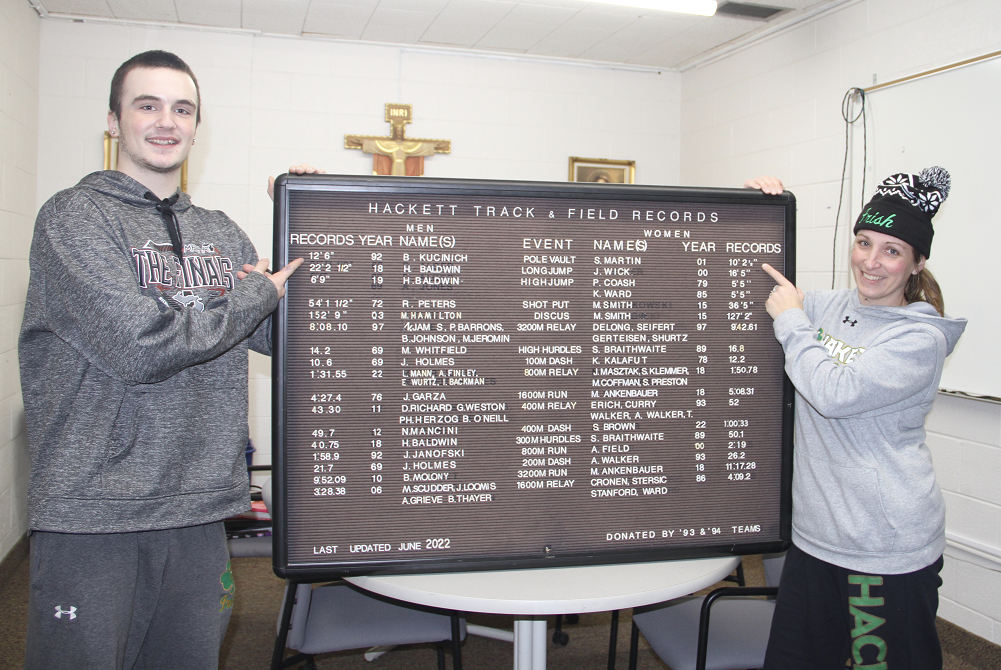
Aspirations High as Reigning Champion Hackett Vaults Into New Season
By
Pam Shebest
Special for MHSAA.com
March 14, 2023
KALAMAZOO — Harrison Wheeler has not been a pole vaulter for very long – two weeks to be exact – but he already has some lofty goals.
 The sophomore is aiming for the Kalamazoo Hackett Catholic Prep record board and, if he makes it, he will be in good company.
The sophomore is aiming for the Kalamazoo Hackett Catholic Prep record board and, if he makes it, he will be in good company.
Coach Shelly (Martin) Germinder, a 2001 Hackett graduate, still holds the girls record of 10 feet, 2½ inches.
“I’m hoping to have my name next to hers (on the record board),” Wheeler said.
The sophomore has a few feet to go before surpassing current record holder Brian Kucinich, who vaulted 12 feet, 6 inches in 1992.
Wheeler’s unofficial best is 9 feet; officially it is 8 feet, 6 inches.
“That is going to be a very big jump in my pole vaulting career,” he said.
Wheeler is one of 42 athletes on the reigning MHSAA Lower Peninsula Division 4 champion boys team, which includes 12 seniors and 13 juniors. Besides Wheeler, the team has six sophomores and 10 freshmen.
One of the returners is senior Liam Mann, who helped lead the Irish to the Finals title last year.
Mann, Andrew Finley, Evan Wurtz and Isaac Backman won the 800-meter relay with a time of 1:31.55 last season, setting a school record as well.
While he lost his relay mates, Mann said there are good runners to replace them.
“(Senior) Brice Brown is coming out to do track, and I’ve been working with him this winter,” Mann said. “Jude Coffman, who is a sophomore, is coming out this year. I think he’s going to be a good addition to our 4-by-1.
“(Junior) Gabe Oeurn, last year he was running solid times, but this year he’s been putting in the work and I think he’ll be able to break that 12-second barrier.”
Mann, who will attend Ashland (Ohio) University on a track scholarship in the fall, also added gold in the 200-meter dash (22.82) last season.
“Last year, I played basketball and was able to lift to keep in shape,” he said. “This year, I wanted to focus all my time on track, so I’ve been doing indoor track, practicing once a week and going to meets on weekends.”
He continued to put his skills on display as a running back during football season with Kalamazoo United, ending the fall with 1,413 rushing yards on 177 carries and 267 receiving yards on 10 catches.
Opportunities & possibilities
The biggest group of competitors impacted by graduation are the sprinters, coach Charissa Dean said.
“Hackett’s been really big on sprinting talent in general,” she said. “But track has 17 events, and only two of them are open sprint events and two are relays.
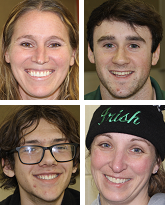 “The other 13 are wide open for possibilities, and there’s a lot of younger talent that’s coming back this year. While they didn’t go to the state meet, they are the next generation of athletes coming up.”
“The other 13 are wide open for possibilities, and there’s a lot of younger talent that’s coming back this year. While they didn’t go to the state meet, they are the next generation of athletes coming up.”
Among that next generation are freshmen Marek Butkiewicz and Sean Siems, who “are incredibly talented athletes,” Dean said.
“(Junior) Gavin Sehy figured out how to do the distance thing this year in cross country.”
Sehy said he wanted to run track, but wasn’t sure where he fit.
“I thought I was mid-distance when I was younger, but my dad forced me to do cross country my sixth-grade year and it turned out I was decent at it so I kept doing (long distance) in track,” he said.
“It’s kind of brutal at times to train for long distance, mentally and physically, because you have to go on long runs, but I have fun with it. At the cross country state finals, I hit an 11 flat split at the two-mile, which beat my 3,200 best from last season, so we have yet to see my best times.”
Butkiewicz and Sehy have been running consistently six days a week all winter to prepare for their first meet, March 22.
“I’ve never done track,” the freshman said. “I know I can perform well. I know my times compared to other people.”
A sophomore this year, Alex Dumont had a 400-meter time that “came out of nowhere,” Dean said. “Toward the end of the season we recruited him to do the 4x8, so an 800-meter runner. That kid came through.
‘We actually took him to the state meet in the 4x8. He did the lead leg, and I clocked him at a 2:07. He was sprinting. It was an amazing leg in that relay.”
Seeing potential
It was Germinder who converted Wheeler to the pole vault last year.
“Harrison’s a strong athlete, and just the way his mind works in that he asks questions and he wants to learn and he wants to improve,” she said.
“He wants to work hard, and he wants to put in the time. That’s something you need for that, along with the athletic component.”
 Wheeler, who said he was shocked at being successful right away, competed for two weeks last season before a foot injury suffered on a vault sidelined him.
Wheeler, who said he was shocked at being successful right away, competed for two weeks last season before a foot injury suffered on a vault sidelined him.
“It took her a whole season to finally convince me to do it,” he said. “I grabbed a pole one day and ended up being really good at it. Ever since, I’ve had a love of it.
“The feeling I have once I get in the air is almost like I’m just floating. When you get really good vaults and you get that nice height and good form, you get what we call a ‘stall.’ You just feel like you’re sitting up in the air for a second. It’s gotta be the coolest thing ever.”
Germinder has the background to help the Irish vaulters.
While at Hackett, she competed in the AAU National Championships and said she learned from the best, Oran Mitchell, a noted pole vaulting coach.
Her own coaching style revolves around the safety of the athletes.
“You can teach a lot of people to grab hold of a pole and pop yourself over,” she said. “But I want to make sure my athletes are safe. That’s really, really important to me, and that’s something that was instilled in me.
“When you’re jumping 6 to 16 feet, that’s a long way to fall. Safety is very important to me. If you’re not willing to put in the time, then I’m not the coach for you.”
Germinder said one of the foundations on which the team is built is leadership, which was instilled in the younger athletes by last year’s seniors.
“That’s one of the things our program is built on,” she said. “If you’re there because you want to get ready for the next sports season, we’ll coach you for that.
“If you want to be a state champion, we’ll coach you for that. That’s the really unique thing about track. There’s something for everyone, whatever that might be.”
As for the girls team, numbers are steadily climbing.
Five years ago, the team had just two girls. This year, 25 girls are on the team.
No matter girls or boys, track or field events, one thing is common for all the athletes.
“We pray before every meet, we put God first, and all those pieces have fallen into place for us.” Germinder said.
“I really believe that foundation is what is going to be our success this year. It’s there, it’s just a different team.”
 Pam Shebest served as a sportswriter at the Kalamazoo Gazette from 1985-2009 after 11 years part-time with the Gazette while teaching French and English at White Pigeon High School. She can be reached at [email protected] with story ideas for Calhoun, Kalamazoo and Van Buren counties.
Pam Shebest served as a sportswriter at the Kalamazoo Gazette from 1985-2009 after 11 years part-time with the Gazette while teaching French and English at White Pigeon High School. She can be reached at [email protected] with story ideas for Calhoun, Kalamazoo and Van Buren counties.
PHOTOS (Top) Hackett's Harrison Wheeler points to the pole vaulting record he hopes to break this season, while pole vaulting coach Shelly (Martin) Germinder points to the record she still holds at the school. (Middle) Clockwise from top left: Hackett head track & field coach Charissa Dean, Liam Mann, Germinder and Gavin Sehy. (Below) The Irish celebrate last season’s Finals championship, from left: Dean, Sehy, Logan St. Martin, Alex Dumont, Mitch Eastman, Nick Doerr and Germinder. (Top photo and head shots by Pam Shebest; team photo courtesy of Hackett track & field.)
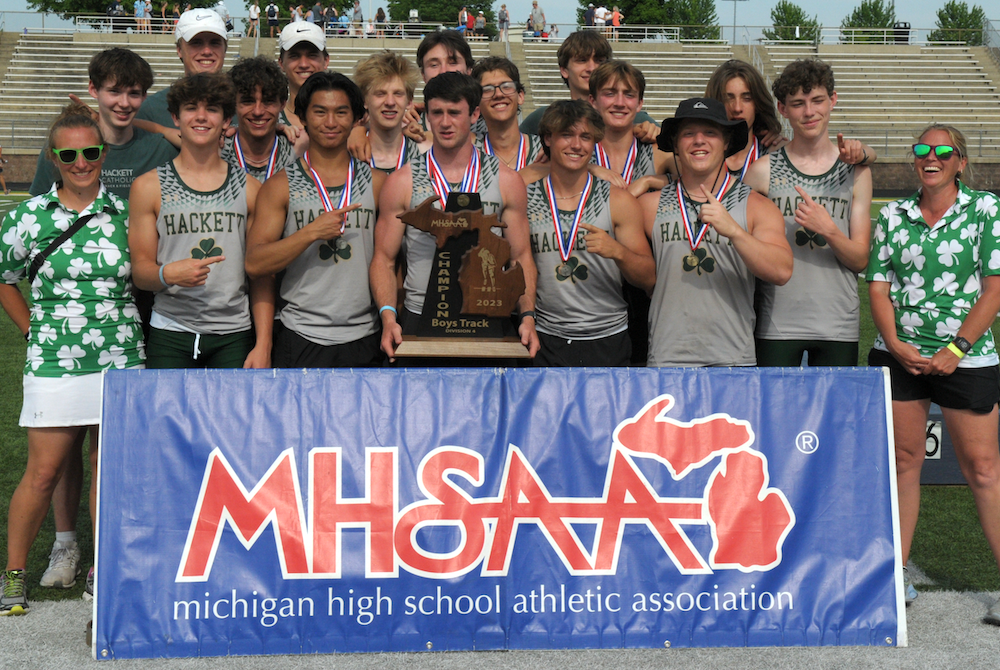
Thrower Claims Lone Individual Title to Lead Hackett to Team 3-Peat
By
Tom Lang
Special for MHSAA.com
June 3, 2023
Kalamazoo Hackett Catholic Prep just keeps winning and winning.
This time the Irish took home their fourth title in the last five Lower Peninsula Division 4 Track & Field Finals, on Saturday at Hudsonville.
Hackett’s only individual title was taken by discus winner Nathan Buchmann, a senior, who was fine knowing he was the shortest in stature among all the sizable competitors.
“In the offseason after football I worked out every day, working towards this goal,” he said after getting his medal. “I would say this takes 80 percent technique and 20 percent strength to throw the discus. So, length can help but if you have good technique and are really strong, that will play into it.
“I think we are very balanced throughout the meet today,” he said about teammates that scored points in finishes other than first place. “We have 13 guys here today, and we have people in a lot of the races. But I do not run; I have too short of legs to be a fast runner,” he said with a chuckle.
Buchmann had to work through a hip injury to compete this spring.
“I think the setbacks are what make you strong,” he said. “You can either give up through the setbacks or push forward and become better.”
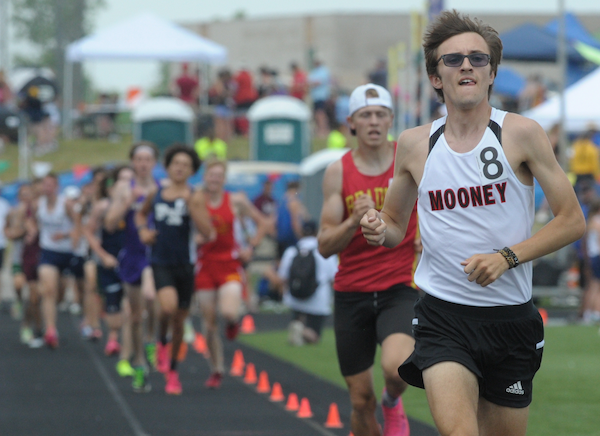 Coach Charissa Dean agreed.
Coach Charissa Dean agreed.
“The kids have big hearts,” she said after all the points were totaled and the Irish were on top once again, with 53. “They worked hard. They had a lot of potential when we started the season. And we had a lot of drive to put in the work, and we are happy the results came out the way they did.”
Reading was runner-up at 47 points, followed by Wyoming Potter’s House Christian with 42, then Fowler and Flint Beecher each with 37 points.
Senior Lezawe “Moses” Osterink, of Potter’s House Christian, placed second in 1,600 but took the 3,200 title as defending champ of both. He dominated the latter by lapping the field with a final lap kick that resembled more of a superhero speedster.
“Nobody really took it out that hard at the start,” he said. “There was a freshman (Marek Butkiewicz of Hackett) that tried to get the pace going quick, but me and Dakota (Dykhuis of Montabella) just kind of sat back and gradually pulled him through.
“We took it gradually, and I was just relying that I could kick.”
Kick did he ever. The trio were neck and neck the majority of the race in a grouping ahead of the pack.
“With 400 to go I just tried to go all out,” Osterink said. “I had a lot more left than I thought and I was pleased with the win. Not really the time, but that doesn’t matter, especially this hot out.”
The overall meet was in the low 90s/high 80s heat and searing sun all day. So, race officials allowed the unique opportunity for coaches to spray the runners with water and give them water bottles.
“It was very weird because I’ve never taken water to drink while I’m running, so I didn’t know how that would feel,” Osterink said. “And they were spraying us and hitting us in the face. It was kind of fun.”
Junior Tyler Lenn of Marine City Cardinal Mooney defeated Osterink at his own game in the 1,600.
“I’m feeling great,” Lenn said after grabbing the medal. “I said to a newspaper after one of my races (during the season) I was right where I wanted to be. This has been a long rebuilding process for me since an injury back in the fall, and I set a pretty high goal the day the injury happened. I was telling myself I needed to fulfill what I said I would do at the beginning of last cross country season. And that is what I did today.”
Lenn suffered an ankle sprain from a misstep that turned worse because he kept running through the season on it.
“Coming back from that was pretty tough, but I wouldn’t have it any other way,” he said. 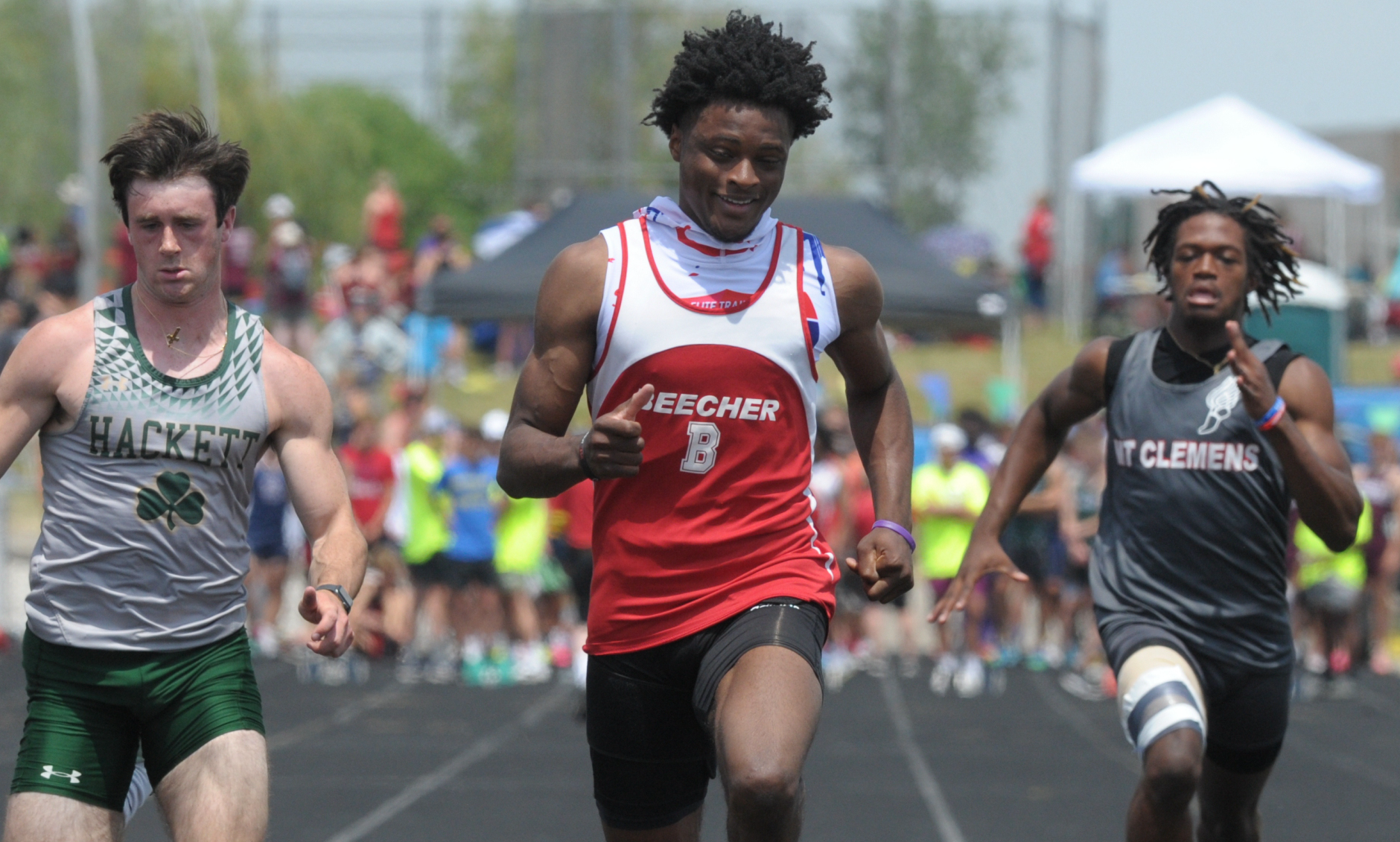 “Perseverance; I said from the beginning what I was going to do. I kept my eye on that target, and no matter the circumstances life threw at me, that I was going to make it happen and I am a man of my word.”
“Perseverance; I said from the beginning what I was going to do. I kept my eye on that target, and no matter the circumstances life threw at me, that I was going to make it happen and I am a man of my word.”
Jaylin Townsend, a senior from Flint Beecher, dominated the short races. He won the 100 dash (10.67) and 200 dash at 22 seconds flat. It was his third 100 win at a Finals.
“I put in a lot of work; I had to three-peat,” he said after the 100. “There’s a lot of great competition here, so I knew I had to come out and run my best.”
Concord in the 400 (43.72), Buckley in the 800 (1:30.76) and 1,600 (3:29.13) and Potter’s House in the 3,200 (8:14.18) were relay champs Saturday. Reading’s Tayshawn Bester won the 110 hurdles (15.13), and Athens’ Landen Bennett won the 300 (39.85). Caseville’s Nathan Feltner won the 400 (50.76), and Vestaburg’s Owen Patton claimed the 800 (1:55.11).
Fruitport Calvary Christian’s Bradley Richards won the high jump (6-10), and Peck’s Alex Affer won the long jump (23-4). McBain Northern Michigan Christian’s Isaac Bowden was first in pole vault (13-0), and Brown City’s Kyle Affer won shot put (49-2).
PHOTOS (Top) Kalamazoo Hackett Catholic Prep celebrates its third-straight LPD4 title Saturday. (Middle) Cardinal Mooney's Tyler Lenn, far right, sets the pace in the 1,600. (Below) Flint Beecher's Jaylin Townsend, middle, crosses the finish first for one of his two sprint championships. (Photos by Ken Swart/RunMichigan.com.)

